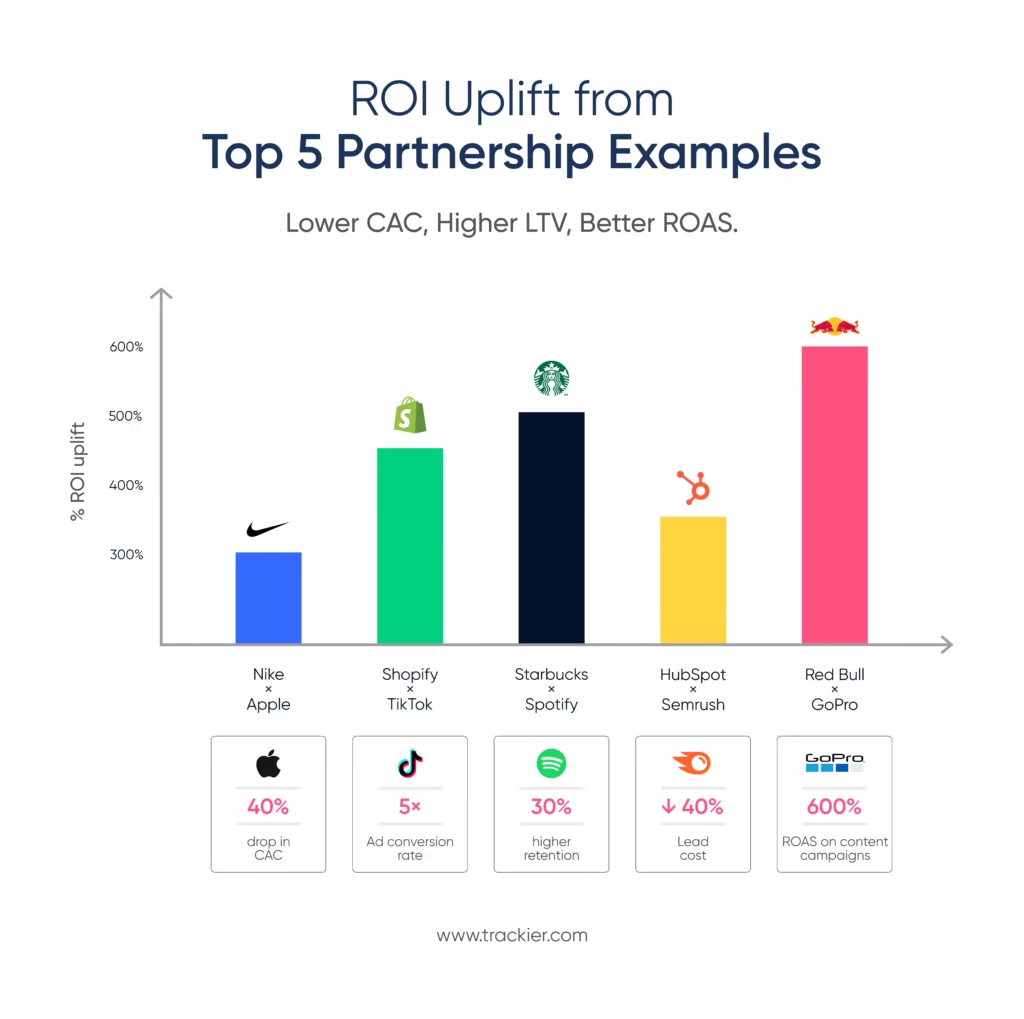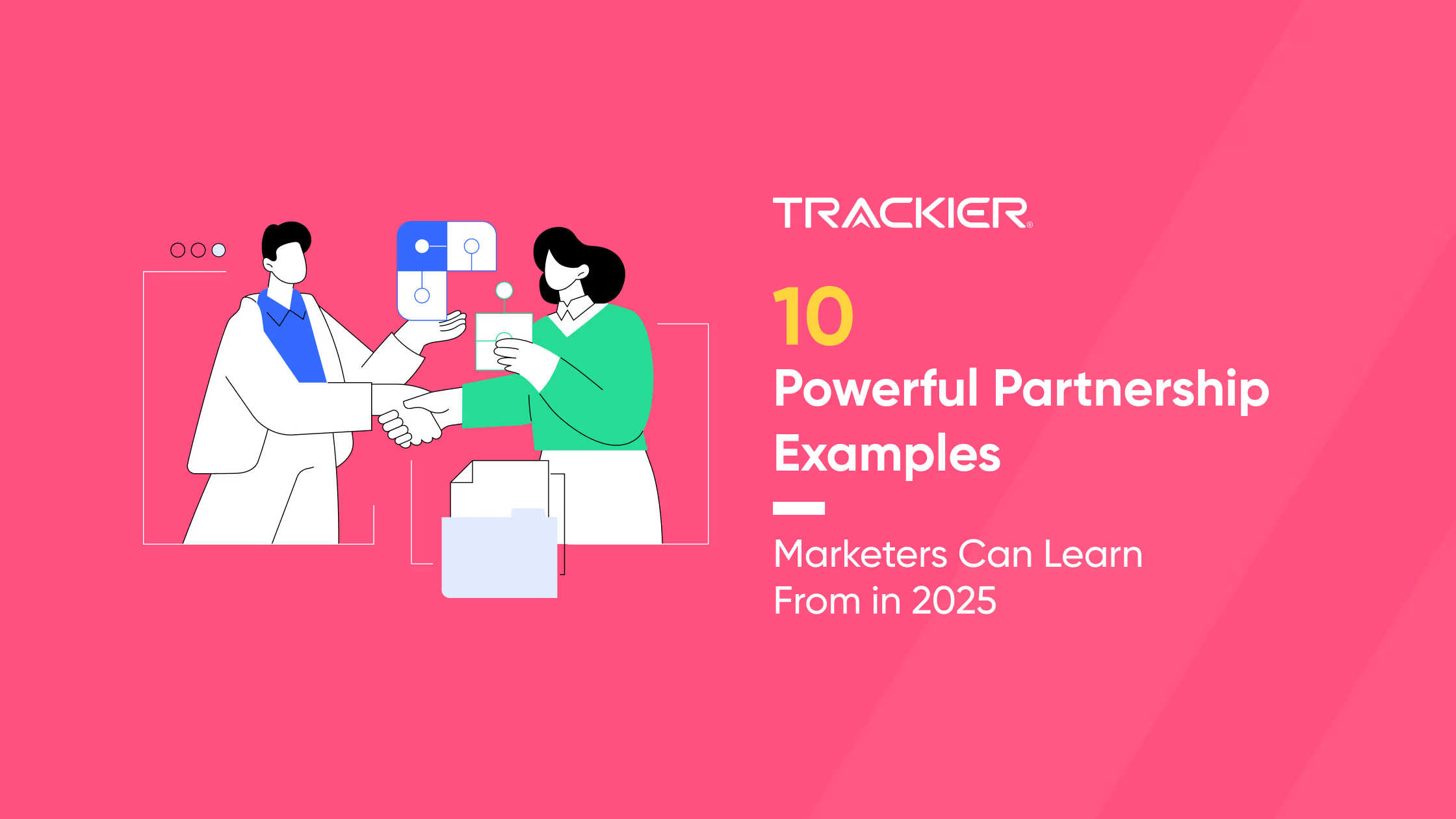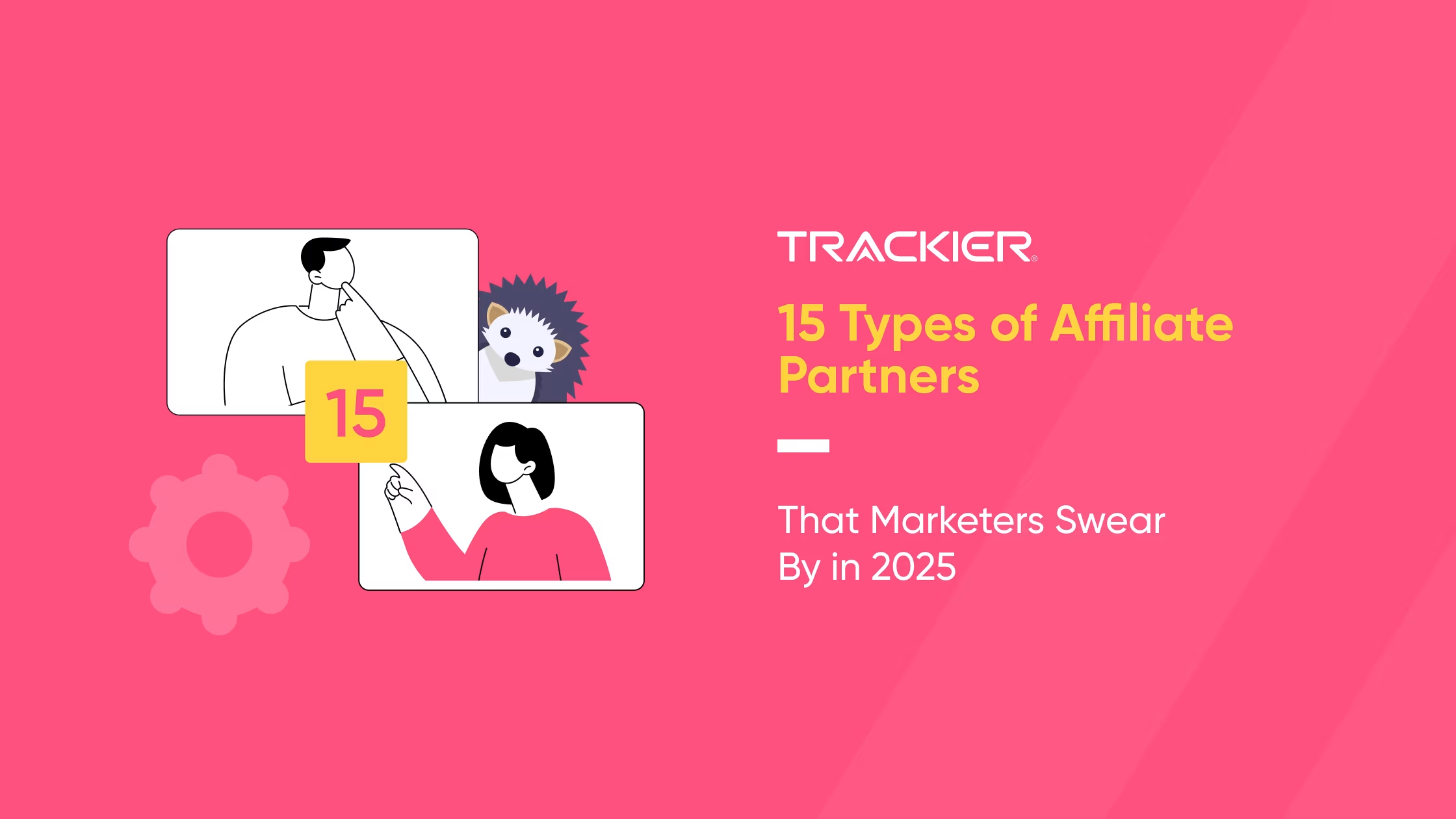Partnership examples are a fool-proof method to make sure that teamwork turns into growth. When two brands join forces and create something much bigger than they could alone is exactly what strategic partnership marketing is all about.
In 2025, partnerships hold key importance in determining how marketers drive engagement, acquire customers, and build long-lasting relationships.
Marketers in every industry look at partnership examples to see how collaborations can spark growth
In this blog, we will walk you through 10 high-impact marketing partnership examples, explain what made them successful, and show you how to use similar tactics for your brand.
Before we dive in, check out Trackier’s partnership marketing strategy guide, a resource packed with tracking tips that make managing partnerships a whole lot easier.
What Makes a Partnership Successful?
Strong partnerships don’t just happen. They’re the result of planning, shared vision, and data-driven execution.
Today, marketers leading with partnership examples focus on:
- Aligned Goals: Both partners must see tangible benefits. When Nike and Apple collaborate, both sell more products and improve customer loyalty, not just one side.
- Complementary Audiences: Partnerships should merge non-competing audiences for mutual gain. Coca-Cola teaming up with Spotify resulted in them reaching younger, music-loving demographics.
- Data Transparency: Metrics matter. Using tools like Trackier’s marketing analytics, you can see which partnerships deliver ROI and which need adjusting.
- Agility and Innovation: Markets evolve fast. A good partnership examples are those who adapt, introducing new campaigns and channels to stay relevant.
Want to understand how ROI differs from ROAS in partnership marketing? Check out Adobe’s guide on ROI vs. ROAS for a clear breakdown.
What Types of Partnership Marketing Models Work Best?
Choosing the right model is step one in designing winning partnership campaigns. These models appear in countless partnership examples worldwide, from co-marketing webinars to large-scale brand integrations.
Here are four major types and why they work.
Strategic Brand Partnerships
Big names team up to deliver something unique. Nike × Apple is a perfect example of brand partnerships examples done right. Nike’s fitness knowledge meets Apple’s tech ecosystem, creating wearables and apps that users love. The partnership opened cross-selling opportunities and increased both companies’ reach globally.
Affiliate and Referral Partnerships
This classic model pays partners for referring traffic or sales. Think Amazon Associates or SaaS partner programs. It’s scalable, cost-effective, and works brilliantly for startups wanting to tap into established networks. These partner marketing examples often result in steady, long-tail revenue streams.
Co‑Marketing & Co‑Branding
When two brands collaborate on content, webinars, or events, they pool audiences without fully merging products. HubSpot × Semrush shows how co-marketing can deliver thought leadership while generating high-quality leads.
Product and Tech Integrations
Technology-driven partnerships like Uber × Spotify or Shopify × TikTok enhance user experience. Integrations make products stickier and reduce churn since customers benefit from combined capabilities.
At this point, you can see how partnership examples cut across fitness, tech, and retail spaces, proving their adaptability.

Real‑World Partnership Examples That Deliver Impact
Here is a list of 10 successful partnership marketing examples for you to see what they did right, and what you can learn from each:
1. Coca‑Cola × Spotify
Hyper‑Personalized Music Campaigns
Coca-Cola partnered with Spotify to let customers scan codes on bottles and unlock custom playlists. This music-driven campaign connected emotionally with younger consumers, boosting engagement rates and app downloads significantly. It’s a prime example of partnership marketing where emotional storytelling drives product sales while enhancing brand recall.
2. Nike × Apple
Tech‑Enabled Fitness Ecosystem
Nike and Apple co-created fitness-focused products like the Apple Watch Nike edition. This partnership merged hardware, software, and fitness expertise to create a seamless experience for health enthusiasts. Sales of wearables soared, and brand loyalty deepened. A brand partnerships example that shows how tech and lifestyle can merge to dominate a market.
3. HubSpot × Semrush
Content & Data Synergy
These two SaaS giants joined forces to offer co-branded reports, webinars, and free tools for marketers. HubSpot’s CRM strength combined with Semrush’s SEO data, helping businesses improve digital marketing strategies. This example, like many other partnership examples in B2B marketing of a partnership, demonstrates how shared expertise can create more value than standalone campaigns.
4. Uber × Spotify
Uber let riders play their own Spotify playlists during trips, making the user experience more personal and fun. This partner marketing example increased app engagement for Spotify and customer satisfaction for Uber, showcasing how small integrations can yield big results.
5. Shopify × TikTok
This partnership allowed Shopify merchants to create TikTok ad campaigns directly from their Shopify dashboards. The integration opened a massive, previously untapped market for small businesses, enabling them to scale without heavy marketing budgets. It’s a partnership business example that democratizes digital advertising.
6. Starbucks × Spotify
Starbucks gave loyalty members exclusive Spotify perks, including curated playlists and free trials. This collaboration kept customers engaged, increased app usage, and drove store visits. A great example of relationship marketing where music strengthened customer bonds.
7. Adidas × Peloton
Co‑Branded Fitness Merchandise
Adidas worked with Peloton to launch fitness gear designed for home workout users. The products sold out quickly, boosting revenue for both brands. It is one of those partnership examples that expanded product lines without needing new distribution channels. Fitness and apparel collaborations remain popular partnership examples because they merge lifestyle branding with functionality, appealing to both partners’ audiences.
8. Red Bull × GoPro
Known for adrenaline-fueled stunts, Red Bull and GoPro partnered to capture and distribute jaw-dropping content worldwide. Viral videos amplified brand visibility, turning customers into fans. This brand partnership example shows how content-driven collaborations can dominate social media.
9. Amazon × American Express
Amazon and Amex introduced credit cards offering Amazon points plus travel perks. This financial partnership not only incentivized purchases but also attracted premium customers, enhancing loyalty programs. It’s a partner marketing example that translates into billions in recurring revenue.
10. BMW × Louis Vuitton
BMW and Louis Vuitton designed bespoke luggage that fit perfectly in BMW sports cars. This co-branded offering appealed to luxury travelers seeking exclusivity. A niche but effective partnership example, showing how luxury brands can co-create lifestyle experiences that deepen customer loyalty.
These operational partnership examples show that collaboration isn’t limited to campaigns and how it can transform entire business ecosystems.
What Business-Side Examples Go Beyond Marketing?
Partnerships don’t just work for campaigns, they have a huge role to play in shaping operations too.
- Product Co-Development: Companies jointly innovate new offerings, like BMW × Louis Vuitton’s luggage line. This speeds up development and attracts overlapping audiences.
- Distribution Alliances: Partnerships between manufacturers and distributors improve supply chain efficiency. For instance, large FMCG brands partner with regional delivery services to cut costs.
- Supply Chain Collaboration: In the present scenario, more brands are sharing logistics infrastructure to lower environmental impact while speeding up delivery.
According to Benepik’s 2025 channel partner loyalty report, businesses that expand partnerships beyond marketing see 20–30% efficiency gains in distribution and operations.
So, what’s the big conclusion you can draw from all these partnership success stories? A few things stand out.
- First off, partnerships open doors to massive new audiences. A big and successful example of this is how Shopify merchants suddenly reached millions of TikTok users, and how they didn’t have to build that audience from scratch.
- Second, you can cut your customer acquisition costs significantly. HubSpot and Semrush proved this when their joint campaigns brought in leads that were about 40% cheaper than what they’d have managed alone.
- Then there’s customer lifetime value. Loyalty-driven collaborations, like Starbucks teaming up with Spotify, keep people coming back for more, meaning every customer is worth more over time.
- Content is another big win. Red Bull and GoPro didn’t just partner up and advertise, their content and copes were so strong and impactful that they went viral without huge ad budgets. That’s the power of creative synergy.
And finally, the partnerships that really thrive? They’re the ones where metrics matter. Brands that stay on top of ROAS, churn, and other key numbers know exactly what’s working and what needs tweaking.
How Can You Measure and Optimize Partnership Marketing Examples?
Tracking metrics transforms good partnerships into great ones:
- ROAS and ROI: Measure how much each partnership returns per dollar spent. According to Neil Patel’s ROAS benchmarks, top-performing brands achieve 400–600% ROAS through partner channels.
- Lead Quality: Use CRM data to evaluate if partner leads convert faster or spend more.
- Churn Rate: Monitor retention to ensure collaborations are bringing lasting customers.
- Channel-Specific Performance: Test multiple models, affiliate, co-branding, integrations, to see which delivers sustainable growth.

Use Google Ads Smart Bidding Strategies to automate paid campaigns within partnerships and maximize return on spend.
What’s Next for Marketers?
We’ve explored 10 real-world partnership examples showing how collaborations can scale businesses fast.
The next step?
- Map potential partners in your industry.
- Select a partnership model that aligns with your goals.
- Define success metrics upfront.
- Use tools like Trackier to track attribution and optimize campaigns.
- Experiment, measure, and double down on partnerships that deliver.
With the right partnerships, 2025 could be your biggest growth year yet.
Hungry for more?
Sign up for our weekly newsletter to get tips like these delivered, straight to your feed.
Subscribe on LinkedInWhat is an example of partner relationship marketing?
Partner relationship marketing is when two or more businesses collaborate not just for a single campaign but to build long-term customer loyalty and value.
A great example is Starbucks × Spotify. Starbucks allowed its loyalty members to enjoy exclusive Spotify playlists and free trials. This was a sustained effort to deepen customer engagement.
Spotify gained more subscribers from Starbucks’ foot traffic, and Starbucks strengthened its loyalty ecosystem through music-driven experiences. This shows how brands can co-create ongoing value rather than focusing only on short-term sales.
Who is Coca-Cola’s marketing partner?
Coca-Cola has had several marketing partners over the years, but a standout recent example is Spotify.
In their collaboration, Coca-Cola used unique QR codes on product packaging that unlocked personalized Spotify playlists. This move connected Coca-Cola with music-loving younger audiences, leading to higher app installs, increased engagement, and better brand recall.
By partnering with Spotify, Coca-Cola didn’t just advertise, it embedded itself in a popular, emotion-driven experience that kept users interacting with both brands long after the initial purchase.
What is an example of a partnership model?
There are many partnership models, but let’s take affiliate marketing as a key example.
In this model, businesses collaborate with affiliates who promote their products or services and receive commissions for every conversion. Shopify × TikTok is a more modern, tech-integrated take on this model.
Through their partnership, Shopify merchants can run TikTok ads directly from the Shopify dashboard, making it easy for small businesses to tap into TikTok’s massive audience. This is a scalable, performance-based model that benefits both partners, TikTok gets more advertisers, and Shopify merchants get social traffic without needing separate tools or agencies.
What are five partnership examples of relationships?
When we talk about partnership marketing, here are five diverse relationship types:
1. Strategic Brand Collaborations – Nike × Apple creating fitness-focused wearables.
2. Affiliate Partnerships – Amazon Associates driving millions of sales worldwide.
3. Co-marketing Initiatives – HubSpot × Semrush delivering joint webinars and reports.
4. Content Collaborations – Red Bull × GoPro producing viral extreme sports videos.
5. Loyalty-Driven Partnerships – Starbucks × Spotify combining rewards and music perks.
Each of these relationship types serves different business goals, ranging from brand exposure to lead generation to long-term retention. They highlight the flexibility and scalability of partnership marketing across industries.
What is an example of relationship marketing?
Relationship marketing is all about nurturing long-term customer connections instead of focusing solely on one-off transactions.
The Starbucks × Spotify alliance perfectly illustrates this. Instead of offering short-lived discounts, Starbucks tied its loyalty program to Spotify’s music platform. Customers could discover curated playlists while earning Starbucks rewards, which enhanced their overall brand experience.
This approach increased app usage, boosted store visits, and built an emotional connection that outlasted any single promotion.



